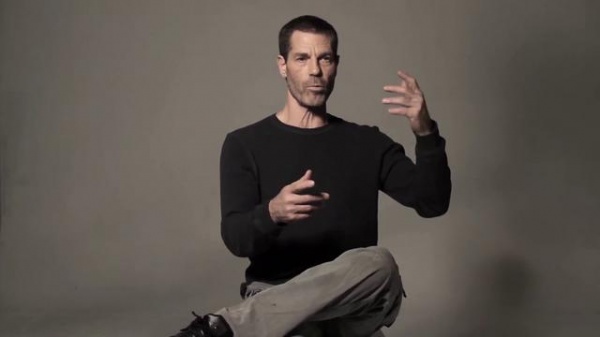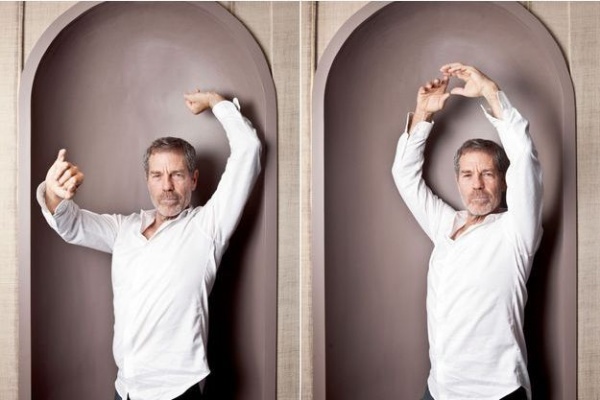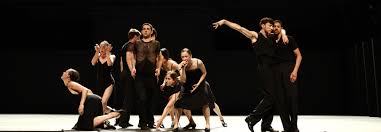ISRAEL MADE ME — OHAD NAHARIN
Posted by Deirdre | Filed under Blog
Israel’s Batsheva Dance Company opens at Toronto’s Sony Centre tomorrow night with a performance of former artistic director Ohad Naharin’s full-length, Venezuela. I shall lead the pre-show Behind The Curtains live conversation with a member of the artistic team, starting at 7pm. I am looking forward to seeing the company again after having covered it in the past. In anticipation, I went back into the archives and found this interview with Naharin from 1995 — before he became world-famous as the inventor of Gaga, a new movement technique. Here it is:
Ohad Naharin, artistic director of Israel’s Batsheva Dance Company, has just walked off the KLM flight that has brought him across the water and into Toronto where his 15-member troupe will begin a limited three-night run at St. Lawrence Centre’s Bluma Appel Theatre starting tonight.
And maybe because it is late and because he is heavily jet-lagged, the 43-year-old former dancer and internationally acclaimed choreographer is a touch tetchy when it comes to talking about his metier.
“It’s impossible to talk about dance,” Naharin declares, threatening to stop any discussion dead in its tracks. “As a friend once said to me, to try to describe dance is like trying to glue a paper wall to the ocean.”
But even tough guys born on a kibbutz in the desert, as Naharin was, have a soft spot and for Naharin his weakness is precisely the thing he doesn’t want to talk about. The trick is not to approach the subject directly, which is fitting, by the way, as Naharin creates works that are subtle, fleeting, seemingly formless.
“Style and vision are words I don’t really use,” he says when asked if he can describe his style and vision. “What I try to do is make my work seem like there is no style. And that’s because I don’t really have a method. What I have is experience and a small amount of wisdom. The work, if it reflects anything, reflects myself.”
Speaking of himself, Batsheva’s artistic director says he began his explorations into movement when he was young.
“I don’t exactly remember or know when I first became interested in dance,” he says after a few moments of heavy silence. “But I always liked the sensation of movement and the physical risk that I found in folk dancing or sports or in animals. What I remember from when I was a kid is that it was always an important part of me. I was always curious about the body, not just for movement but as a creation, and for what the body could produce and for how other people could use the body as a tool for their own creativity.”
He was relatively old – 22 – when he decided to act on this curiosity of his.
He started with dance classes in Israel and soon received a scholarship to study in New York at the School of American Ballet and also with the Martha Graham company.
Modern dance, which is what the Graham school emphasized, captured his attention more than ballet although ballet continues to fascinate him. Much of his own choreography has been for ballet companies, including Nederlands Dans Theater, The Frankfurt Ballet, Sweden’s Cullberg Ballet and Pittsburgh Ballet Theatre. His works are also in the repertoire of Canada’s Les Grands Ballets Canadiens.
“I like working with ballet dancers,” he continues, his innate enthusiasm for dance making him speak now a little more rapidly and enthusiastically about his chosen art form. “And I like to see what I can do with ballet dancers and what I can do for dance. I don’t see anything wrong with that as I don’t really see any division between ballet and modern dance. For me those divisions are very artificial. I don’t need labels in dance. For me I feel a freedom in my work to use ballet and the tools of the ballet dancer.”
Although Batsheva is a repertory company, for its Toronto shows it will present only works by Naharin. Program A (opening tonight) is a mixed program featuring Queens/Black Milk, Kaamos and excerpts from the full- length work, Kyr. Program B (opening Friday) features the full-evening work Mabul.
“My movement has nothing to do with formal training,” he continues. “It has a lot to do with defining what is the quality of life.” But there’s more. “My dancers have to move as if they have a purpose, as if for them dancing is survival or what it means to survive.”



